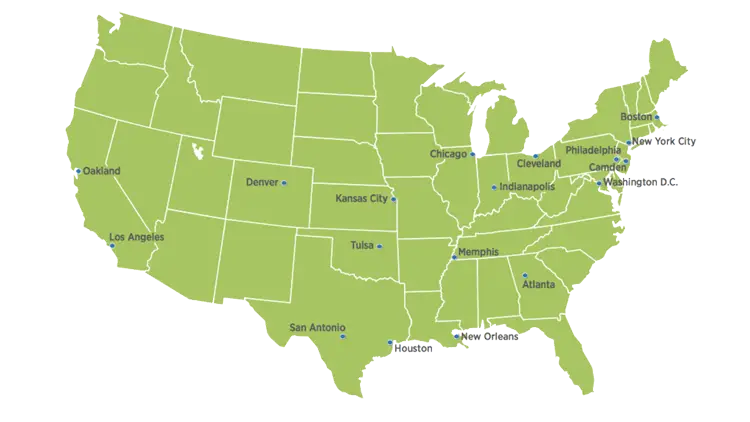In 2017 CRPE published an analysis of student and school outcomes in 18 high-choice cities. It showed us that many cities were closing the gap between the city and state on key outcomes like graduation. But while the education system as a whole improved, achievement gaps by income and race/ethnicity remained. Across the country, disadvantaged students continue to trail behind their peers—a reality that gains greater urgency as school systems prepare the next generation for a rapidly changing economy and an increasingly interconnected world.
Policymakers and system leaders need to ask: What can we do to prepare every child for the future? Do school leaders and educators have the necessary flexibility at the school and classroom level? Do they have the funding and other resources to meet the needs of the students they serve? Are they working in systems that support innovation and continuous improvement?
To prepare every child for the challenges and opportunities ahead, America’s school systems must become more agile. That may require them to rethink everything from governance to funding to the range of learning experiences available to the students they serve.
For the past two years my CRPE colleagues and I have tracked education strategies to help policymakers, system leaders, and funders understand how cities with public school choice are delivering education. The 18 cities in our study differ in size and location, but each has adopted at least some elements of a portfolio strategy—a problem-solving framework designed to ensure that all students can access a high-quality education and that the education system is nimble enough to address changing student needs.
In our newest analysis, we explore trends that emerged from interviews with district and charter leaders, nonprofits, and civic leaders. Here we see signs for optimism, as well as persistent challenges. We see system leaders working to improve family experience with school choice and school quality; these are tailwinds that can be used to push initiatives further. System leaders can also learn from key sticking points—areas where attention should be put now.
Which strategies did cities focus on in 2018?
- Making it easier for families to navigate school options by consolidating information about schools into guides and simplifying application and/or enrollment processes. For districts and charter schools, efforts to consolidate information or enrollment processes have often resulted in protracted battles. Over the past year we saw schools and school systems more willing to be transparent and collaborate with one another. But much remains to support underresourced families through the process, like using existing community-based groups to help families choose and apply to schools. School information guides must be user-friendly and include comparable academic information in addition to things like school culture and specific student services. (Listen: Here’s where we saw progress in cities.)
- Adding new or expanded school leadership programs for both districts and charter schools. Over the past two years we saw a lot of investment in school leader and teacher programs. School systems and funders can use this momentum to create more effective, targeted talent strategies that align with the overall school improvement strategy and models. This may be a turnaround strategy, district autonomy strategy, or personalized learning model. Better data and more targeted recruitment and retention will help ensure systems have the teachers they need. (This blog offers ways that charter schools can be more strategic about recruiting, hiring, and retaining teachers.)
- Improving system responsiveness with increased family involvement in school openings, redesigns, improvements, and closures. Families were being asked to weigh in on new school models, operators, and school improvement plans. This is a positive trend, but systems must be put in place so opportunities are not ad hoc. Charter and district leaders are providing more avenues for input, especially on large strategic initiatives, but they must remember to close the feedback loop. An education system that is nimble and responsive is more likely to sustain the changes it makes. (Listen: Christine Campbell shares recommendations for cities to expand this work.)
What were the most pressing challenges for cities?
- Improving access to public school options by revamping transportation policies. Access to quality schools remains a major barrier for families. In some cities, improving transportation is not feasible, so leaders must double down on improving or siting high-quality schools in every neighborhood.
- Strategically managing the city’s school portfolio to locate quality schools, district or charter, where they are most needed, as well as improve, restart, or close low-performing schools. In our interviews, system leaders noted several barriers in this work, like lacking transparent data for all schools in the city and consistent criteria to guide decisions. Many cities are interested in using school turnaround to improve existing neighborhood schools, but this continues to be very challenging work. It requires more operator and talent capacity than many cities have. The barriers are not only technical. In places where the district and charter schools cannot work together, the lack of collaboration means a new charter school may open across the street from a school the district is trying to turn around. And poor engagement in the past—like closing schools on short notice or not involving community members in the larger strategy—has resulted in mistrust of any new initiative. (Listen: Georgia Heyward shares three recommendations for districts, charters, and funders to improve accountability and supply decisions.)
- Giving district schools greater flexibility over their funds, weighted for student needs, so schools have the resources they need to drive improvement. In our 2018 interviews, district leaders in many cities expressed interest in giving schools greater decisionmaking authority. However, leaders said they needed help making the necessary central office and school-level changes. Districts that already used weighted student funding struggled with ensuring that low-performing schools had the resources and supports they needed to improve. While few systems pushed for greater budgetary flexibility, several districts expressed interest in increasing school leaders’ flexibility over curriculum, staffing, and/or scheduling. (Listen: Christine Campbell discusses the challenges reported by district leaders.)
No one has an answer yet about how to reduce achievement gaps in American public education or how to best address individual student needs. But we do have an idea for what makes a nimble and responsive education system. Making sure those elements are in place can give system leaders the tools they need to address issues as they arise. To learn how some cities are tackling these and other sticking points, see our Strategies in the Spotlight.
Learn more about how we conducted this study, compare results across cities, and read individual city progress reports.





